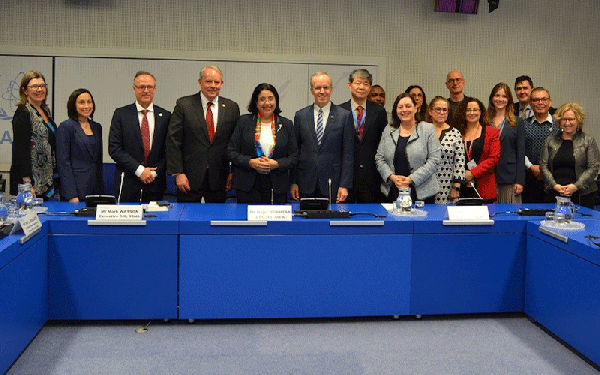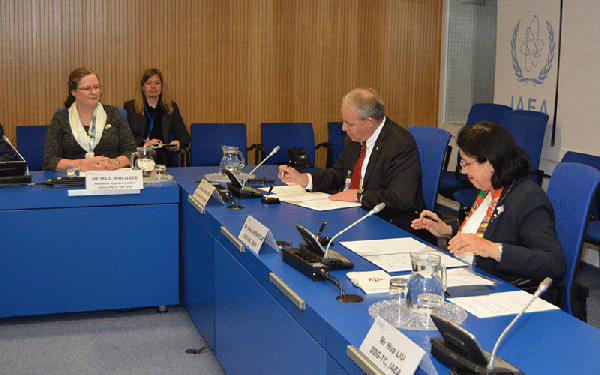The IAEA Joins Forces with RSNA to Advance Radiology Capacities in Low and Middle Resource Countries
Partnership will promote health equity and combat global health care disparities

In a significant move toward bolstering diagnostic and medical imaging capabilities in underserved regions across the world, the International Atomic Energy Agency (IAEA) and RSNA have forged a strategic partnership agreement whose overarching goal is to build professional capacity in radiology across low and middle resource countries (LMRCs).
The agreement was signed by Najat Mokhtar, Deputy Director General and Head of the Department of Nuclear Sciences and Applications at the IAEA, and Mark G. Watson, RSNA Executive Director. Speaking of the agreement, Mr. Watson said, “RSNA is proud to be part of this partnership with IAEA, and we look forward to working together to raise awareness and address health care disparities in underserved areas. RSNA is strongly committed to promoting health equity and improving access to care around the world. Through collaborations such as this, we are able to bring high-quality radiology resources and training to the places that need them most.”
Renowned for its commitment to excellence in patient care through education, research and technologic innovation, RSNA members span the full breadth of radiology subspecialities and represent over 150 countries. By leveraging RSNA's extensive network and resources, the IAEA seeks to amplify its efforts in promoting equitable access to high quality radiology services in LMRCs, notably through its Rays of Hope initiative.
“The IAEA-RSNA collaboration is a pledge to expand our efforts in combating global healthcare disparities, particularly in cancer care,” said IAEA DDG Najat Mokhtar. “Imaging is an integral part of cancer care, but unfortunately there are still countries that do not have access to diagnostic tools and procedures which are integral for the proper diagnosis and staging of cancer in patients—this collaboration will be a step forward towards building these capacities."

Medical imaging plays a vital role in achieving the best health outcomes for cancer patients—from diagnosis, to disease staging, to therapeutic planning, and the assessment of therapeutic response, medical imaging is an essential tool used to guide all major medical decisions.
“Medical imaging is pivotal in every patient’s continuum of care,” said RSNA President Curtis P. Langlotz, MD, PhD. “By working together to bring key medical imaging services and resources to underserved parts of the world, the IAEA and RSNA can make great strides toward reducing healthcare disparities and improving patient outcomes.”
Based on a microsimulation of 11 different cancers, modelling experts from the IAEA’s Division of Human Health have projected that increased access to medical imaging worldwide in a ten-year period would avert 3.2% (2.46 million) of all 76 million deaths caused by the modelled cancers, thereby saving 54.92 million life years.
This agreement notably builds on the collaboration between the IAEA and RSNA, which played an important role in the Lancet Oncology Commission on Medical Imaging and Nuclear Medicine.
"The Commission report, published in 2021, spotlights dramatic inequalities in imaging resources and outlines a compelling health economics case for countries, illustrating that scaling up access to medical imaging for cancer patients would yield substantial health and economic benefits," stated May Abdel-Wahab, Director of the Division of Human Health, Department of Nuclear Sciences and Applications.
Key highlights of the agreement include:
- Outreach and Advocacy to collaborate on awareness-raising of global healthcare inequalities, especially but not only for cancer imaging.
- Capacity Building towards enhancing the skills and expertise of healthcare professionals in radiology through educational programs, conferences, and knowledge-sharing initiatives.
- Increased access to radiology networks, educational materials, and global learning programs offered by RSNA for continuous professional development.
- Collaboration in research and innovation, promoting the exchange of best practices and the development of strategic frameworks to address evolving healthcare challenges.
“Our alliance with RSNA is not just about cooperation; it is about mutual dedication to improving healthcare outcomes and ensuring that quality medical imaging services reach every corner of the globe,” said Lisa Stevens, Director of the Programme of Action for Cancer Therapy, IAEA Technical Cooperation Department.